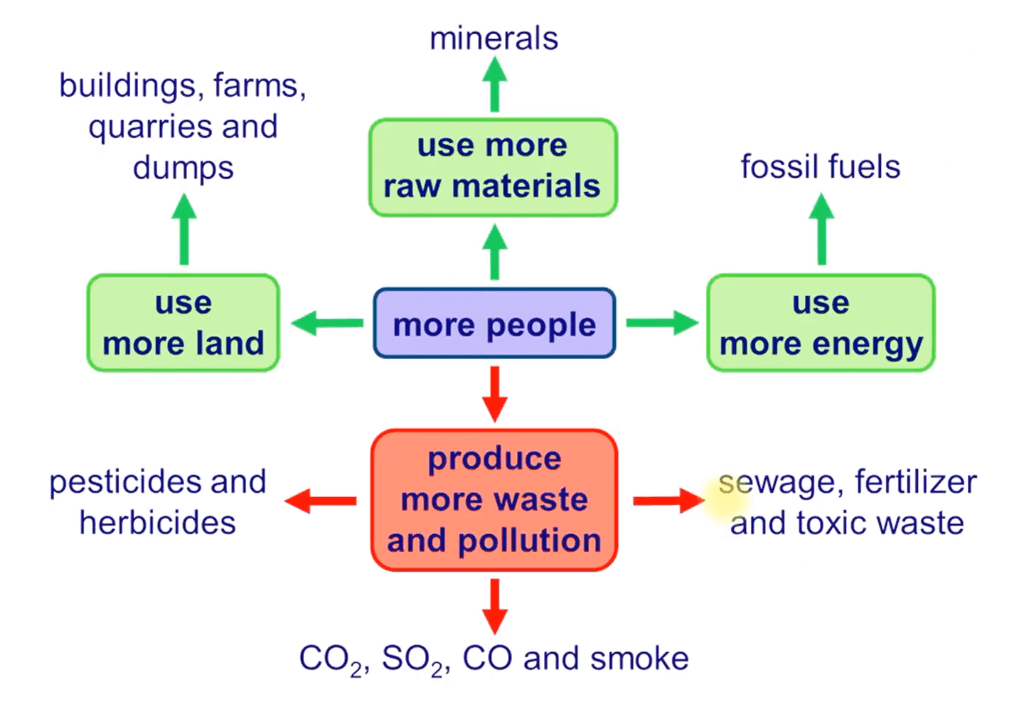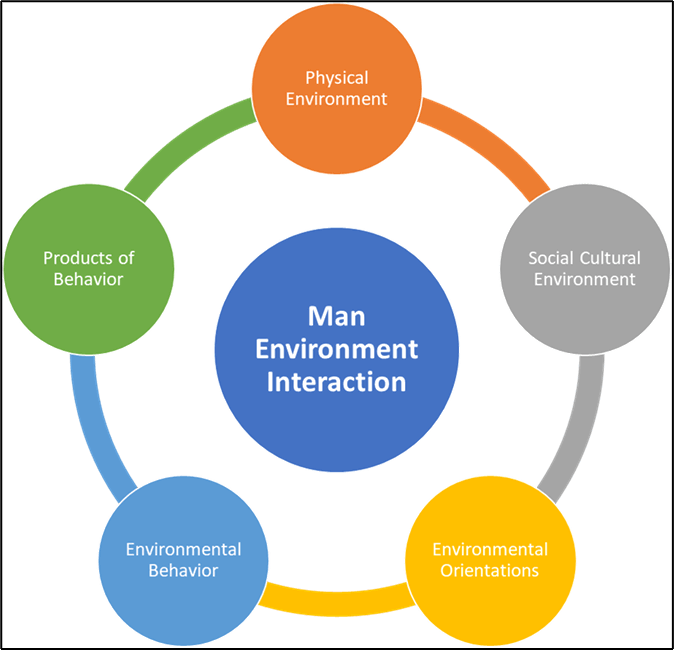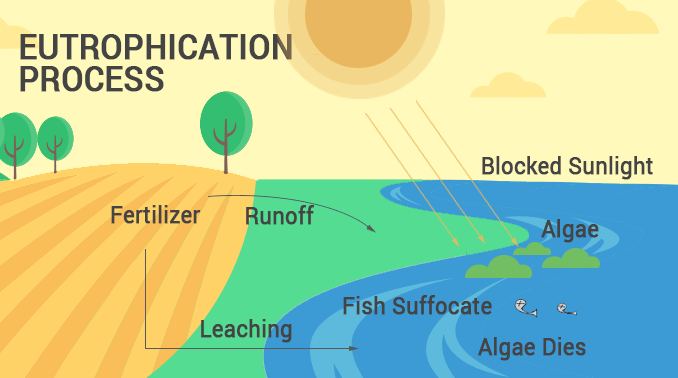In this article, You will read Influence of Man on Ecology and Environment – for UPSC IAS (Geography Optional).
Influence of Man on Ecology and Environment
- Man’s relation with his natural environment is a complex one. While he is subject to certain natural controls and events, he also acts as the dominant force in many of the Earth’s physical and biological systems. The relationship has changed with time. Increasingly, man has become capable of altering his physical environment to suit himself.
- Although the scale of man’s impact on the environment has accelerated rapidly since the Industrial Revolution, man has been a factor in environmental change for at least 40,000 years, since the late stages of the Pleistocene ice age.
- Although the object of these alterations was to improve his living conditions, in some cases they have created major long-term problems, and in still others, they have been catastrophic, both for the natural environment and for him.
- We shall consider some of the ways in which climate, landforms, soils, and ecosystems have been inadvertently altered by man.
- Humans impact the physical environment in many ways: overpopulation, pollution, burning fossil fuels, and deforestation. Changes like these have triggered climate change, soil erosion, poor air quality, and undrinkable water. These negative impacts can affect human behavior and can prompt mass migrations or battles over clean water.

Modification of Landforms
- Mining and quarrying, deforestation, the introduction of exotic plants and animals, the use of agricultural machinery, the building and use of tracks and roads, and the overgrazing of pastures, have all, singly and in combination, profoundly altered landforms and caused accelerated erosion and deposition to occur.
- Where man excavates or piles up material himself, he can be regarded as a direct agent of change; where he causes natural landform processes, such as wind and water action, to accelerate or diminish, he is acting in an indirect manner.
- Indirect effects are by far the most widespread. Much of this influence occurs accidentally or secondarily to some other purpose; conscious attempts to influence landform processes—for example, by building coastal groynes or by re-afforestation— are inevitably expensive and limited in extent.
Direct Alteration of Landforms
- Man has a direct effect on the shape of landforms by excavating and piling up the earth, reclaiming land from the sea, and causing subsidence through mining. These activities have greatly increased since the Industrial Revolution with the development of enormous machine power and explosives
for moving material. Land scarification is sometimes used as a general term for disturbances created by the extraction of mineral resources; open-pit mines, quarries, sand, and gravel pits are among the forms of scarification. Strip-mining is one of the most devastating examples of landform alteration of this kind. - Equally obvious as man-created landforms are coal tips and other waste heaps from mining and quarrying. Many of these features are geomorphologically unstable, allowing various forms of the mass movement to generate. When saturated by heavy rain, spoil tips are frequently subject to sliding and flowage, supplying sediment that clogs stream channels.
Indirect Effects: Slopes and Rivers:
- By far the most important of all man’s effects on landforms are those connected with his interference with the natural vegetation, in particular with the clearing of forest for agricultural purposes. There is a close relationship between the amount of vegetation cover and erosion rates on hill slopes, and hence with the amount of sediment in streams.
- A stable vegetation cover acts as an effective regulator of natural erosion, protecting the ground from direct raindrop impact, absorbing some of the run-offs, and making the slope more cohesive. With the removal of the vegetation, the surface loses its plant litter, causing a loss of soil structure, cohesion, and porosity. Multiple shoe-string rills and gullies on hillsides are often a typical manifestation of man’s indirect effect on slopes.
- The alteration of infiltration and run-off on slopes by modifying the vegetation inevitably has a profound effect on adjacent rivers in at least two respects: by increasing both the discharge and also the sediment supply.

Wind Deflation
- The phenomenon of the dustbowl in the Great Plains region of America in the 1930s is a well-known example of man-induced land erosion. The area was former grassland underlain by rich brown and chestnut soils, but both overgrazing and ploughing contributed to the catastrophe which caused the widespread abandonment of farms.
- A great expansion in wheat cultivation in the early years of the decade was followed by a series of droughts; the soil, largely exhausted of its natural fertility, was subject to deflation and particle drifting of disastrous proportions. The dustbowl situation is by no means unique. In the marginal areas around today’s hot deserts, such as the Thar desert of Pakistan and India, and the Egyptian desert, a great deal of deflation is initiated by grazing animals.
Coastal Erosion and Deposition:
- Man can have relatively little impact on the forces that govern waves, tides, and currents, but he has had some effect on coastal erosion and deposition at the shoreline by building various structures and by removing beach material for ballast or construction.
- Hence various engineering structures such as groynes, breakwaters, and seawalls have had to be built to check marine erosion. However, these are not only extremely expensive to build and maintain, but often defeat the object of the exercise, since by checking erosion in one place they may lead to its increase elsewhere.
Modification of the Atmosphere
- The global heat balance has changed over the last few decades, and we might ask ourselves how much of this a result of man polluting the atmosphere is. It is certainly evident that pollution has marked local effects on the atmosphere.
- Atmospheric changes induced by man may be grouped into three categories:
- The introduction of solids and gases not normally found in the atmosphere (pollutants);
- changes in proportions of the natural component gases of the atmosphere; and
- alterations of the Earth’s surface in such a way as to affect the atmosphere.
Pollutants in the Atmosphere:
- To city-dwellers the most obvious way in which man has affected the atmosphere is through pollution. Pollutants include particulate matter, both solid and liquid particles, and gaseous substances such as sulphur dioxide (S02), oxides of nitrogen (NO, N02, N03), carbon monoxide
(CO) and hydrocarbon compounds. But not all man-made pollution comes from cities. Isolated industrial activities frequently create a footprint of atmospheric pollution in areas of countryside downwind from the industrial site. - Mining and quarrying activities also send large amounts of mineral dust into the air. Even man-induced forest and grass fires as well as bonfires, can greatly add to particulate pollution at certain times of year.
- Once in the atmosphere, the primary pollutants undergo a number of chemical reactions, generating a secondary group of pollutants. For example, sulphur dioxide (S02) combines with oxygen and suspended water droplets to produce sulphuric acid. This acid is harmful to organic
tissues and is also very corrosive. Photochemical reactions are brought about by the action of sunlight: for example, sunlight acting on nitrogen oxides and organic compounds produces ozone (03). Another toxic chemical produced by photochemical action is ethylene. - The harmful effects of atmospheric pollution on plant and animal life are manifold. For humans, many pollutants are irritant to the eyes and dangerous to the respiratory system.
Changes in Atmospheric Gas Levels:
- Of the main natural constituent gases in the atmosphere, carbon dioxide (C02) and oxygen (02) are the most critical from an environmental viewpoint, for both are inextricably involved in the
biochemical cycles between atmosphere and the surface of the Earth. Although nitrogen comprises four fifths of the atmosphere, its inert chemical nature relegates it to a minor role in this respect. Oxygen and carbon dioxide are naturally added to the atmosphere by ‘out gassing’ from the Earth’s interior. The work of plants has been essential in removing carbon dioxide from the atmosphere and storing it as coal and other fossil organic substances. - Before the Industrial Revolution, carbon dioxide levels appear to have been about 290 parts per million in the atmosphere. But in the last hundred years or so, this amount has increased by about 40 per cent to 400 ppm, largely because of man’s use of fossil fuels. It has been suggested that,
in contrast to the effect of solid particles, an increased level in carbon dioxide content will increase the temperature of the atmosphere, since the gas is an absorber of long-wave radiation. - It has been pointed out also that man’s large-scale combustion of hydrocarbon fuels requires a large quantity of oxygen to be withdrawn from the atmosphere and converted into carbon dioxide and water vapour. There is therefore the possibility of a lowering of the oxygen content of the
atmosphere to levels which might have a detrimental effect on animal life. - Changes in water vapour levels brought about by man through combustion and alterations to the vegetation cover could in theory markedly affect global radiation and heat balances in the same manner as changes in carbon dioxide levels. But water vapour content varies greatly from place to
place and it is difficult to measure global changes.
Alterations to the Earth’s Surface:
- Meteorological processes close to the ground are extremely sensitive to the character of the Earth’s surface and man’s alteration of this through deforestation, agricultural practice and urbanization has had several important effects. One result of these activities is to alter the rate of evapotranspiration. The complete removal of a forest cover will sharply reduce transpiration and thus the amount of water returning to the atmosphere in vapour form.
- Another important consequence of surface change is to alter the temperature characteristics of the atmosphere nearest the ground; closely built urban areas develop their own heat island on calm nights in summer.
- A third climatic element that may be modified when man alters the ground surface is the wind. Trees and hedges effectively break the wind, causing a simultaneous diminution in evaporation and in the carbon dioxide exchange close to the ground.
Modification of Ecosystems
- With the beginnings of agriculture, far-reaching effects, both obvious and subtle, were introduced into ecosystems. Man gradually became more sophisticated in knowing just how much to modify an ecosystem in order to harvest the crop he wanted. In achieving this end, he has inevitably simplified ecosystems, disrupted nutrient cycling, introduced alien species and eliminated others, and caused pollution. Only in recent years has there been an awareness of some of the consequences of ecosystem modification.
Simplification:
- The most general effect of man on ecosystems is that he tends to simplify them. This comes about because man’s prime concern is to direct energy and material cycling in the system towards him so that he can easily crop them. Species other than the ones he wants to crop are regarded as weeds or pests, and he attempts to eliminate them. Hence, reduction in species diversity, often to a single species population, is a notable characteristic of man’s impact on ecosystems.
- The degree of simplification varies enormously. In remote areas still only inhabited by hunters and gatherers, man may in fact add another trophic level to the rest of the food web. Primitive shifting agriculture in tropical rainforests represents only a temporary simplification and cropping
of the natural system as the plot is only cultivated for a few years and then abandoned. On the other hand, grazing economies exhibit a much greater degree of ecosystem simplification. - Ecosystem simplification of this type often results in disastrous side-effects. A single species population, such as a field of wheat or a herd of cows, offers great opportunity for the development and spread of disease, pests and parasites.
Eutrophication:
- When chemical fertilizers are applied to the land, many of the elements contained in them are retained by the soil, adding to the clay humus complex. However, certain ions are not retained, and among them is a nitrate, an important constituent of most fertilizers. Nitrate is being added to the soil from fertilizers and nitrogen-fixing plants at a much faster rate than it can be broken down by denitrifying agents in the soil. Being soluble, it is rapidly leached out into rivers and lakes. Here, the increased nitrogen input permits the accelerated growth of plants, algae, and other phytoplankton: this chemical enrichment resulting in increased productivity is called eutrophication.
- Unfortunately, in an extreme form, the outcome is ultimately harmful, since the plants and organisms die and decompose at such a rapid rate that oxygen levels fall until aquatic life becomes impossible. A severe example of eutrophication has occurred in recent years in Lake Erie, North America, where deep layers of decaying organic matter have covered large stretches of the shoreline.

Effect on Individual Species:
- The extinction or reduction in numbers of plant and animal populations is a well-known consequence of man’s impact on the environment. Often the species become endangered not so much by hunting or conscious elimination, but by the disruption and fragmentation of habitats. Some species, particularly large predators, require an extensive area of specialized habitat in which to breed and hunt, and fragmentation of this by man’s interference has frequently had disastrous effects. The marsh harrier {Circus aeruginosus} a large raptorial bird of reed beds and fens, is a prime example of this.
- A contrary but equally far-reaching effect has been the accidental or purposeful introduction of alien species into ecosystems. Some animals and plants, because of their greater genetic adaptability and high reproductive rates have often made places for themselves at the expense of
native species. - Under natural conditions, ecosystems have been in a state of ecological equilibrium. With the increasing impact of man, their essential characteristics are altered, so that now signs of severe imbalance or a declining efficiency are beginning to be observed in many of them. This is shown, for example, by the progressive devastation of formerly good fertile agricultural or grazing land through over-intensive use; in the reduction of species when secondary forest replaces primary forest; in a general loss of biological productivity; and in an increasing amount of pollution.
Positive Effects of Human Activities
- Not all the ways that humans affect the ecosystem are negative. Every time you recycle used paper, plastic, or metal, or pick up a piece of trash from the sidewalk, you have a positive impact on the environment. Others are committing their time and energy to large projects to positively change the ecosystem.
- In 2011, for example, a 16-year old inventor named Boyan Slat created a device that can sweep the plastic from the ocean. He later founded The Ocean Cleanup project to begin putting that technology to use. It could clean up half the plastic currently in the Great Pacific Garbage Patch in five years.

BEST
thank u so much…